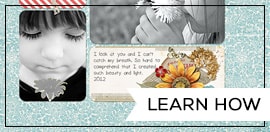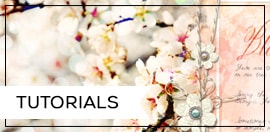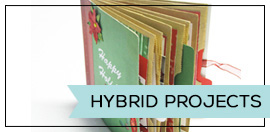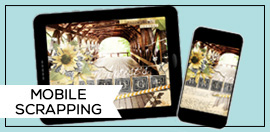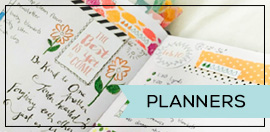
This month’s
ScrapSimple Club is a wonderful selection of paper templates, paper overlays, masks, and brushes that can be used in your digital scrapbooking in any number of ways. Each part of the club lends itself beautifully towards an Art Journaling theme, but each can also be used for everyday digital scrapbooking.
I particularly love the versatility of the paper templates. Each paper looks like a rich, painted paper with a variety of shapes and textures within. The more you look, the more you see! The best thing about the club papers is that they are layered – each paper consists of a number of layers with each characteristic available to treat as its own entity. With that versatility, there are a zillion ways to use those layers. Let me show you some examples of how you can do that!
Below is my layout with an Art Journal theme. I’m going to show you how the layout was built using the paper template layers. Let’s start at the bottom of the Layers palette and work up so you can see how each layer was treated.
But first, let’s look at the palette for just the paper template layers. This is what you will see when you open the PSD file found in ScrapSimple Paper Template: Media Circus. This is template1. Because each characteristic is separated from the other, each layer can be treated differently.

Let’s look at the bottom layer named Texture. This will be the background color of the layout. As with many things in Photoshop, there are many ways to recolor an item. In this layout, the texture layer was recolored by using the Color Picker tool and selecting a color from within my photo, then changing the Hue & Saturation.
To do this, from the Menu Bar, go to Image > Adjustments > Hue & Saturation. Then click on the little box that says Colorize. From there, the sliders can be adjusted to your liking.
The saturation and brightness of the color I chose caused the texture to wash out a little bit, and I didn’t want to lose that characteristic in my layout. In order to address that, another copy of the texture layer was brought in on top of the layer that was just recolored, and the Blending mode changed to Color Burn. This brought out more

One additional step that I did to bring more depth and richness to the layout was to incorporate ScrapSimple Paper Template: Media Circus Overlay from the club. The Paper Overlays differ from the Paper Templates in that the overlay is a single layer. Overlay 6 was brought in and placed above the second texture layer that we just added. The Blending mode on the Overlay 6 layer was changed to Overlay. This brought even more texture and interest into the background layer.

The next layer up in ScrapSimple Paper Template: Media Circus _Template 1 is named Blendable Layer. In my layout, I chose to use this layer as a clipping mask for my photo. By changing the Blending mode of Blendable Layer, the characteristics of that layer (in this case, paint strokes) are visible in your photo. If you left the layer with a Blending mode of Normal, your photo would take on only the shape of the paint swatch. In my layout, the Blending mode of this layer was set to Overlay.
Instead of a photo, you might choose to clip a paper to the Blendable Layer or just change the Blending mode of the layer and let it stand alone!

Next, let’s look at the honeycomb layer. I wanted the honeycombs to look like they were within the sand in the photo; however, I didn’t like the amount of overlap that it had with my photo. A layer mask was used and portions of the honeycomb layer that interfered with the primary focus of the photo were brushed out.

In addition, the Blending mode was changed to Overlay to help make the honeycomb look like part of the sand. See how the honeycomb looks like it’s under the water? The Blending mode is what allows that to happen.

Just for fun, let’s look at another option for the honeycomb layer. Instead of changing the Blending mode on the layer, let’s add a style to it instead. With the ScrapSimple Tools – Styles: Emboss and Engrave Super Biggie style applied, the honeycombs actually look embedded into the sand. See the difference? Adding styles to any of the paper layers will allow infinite creative possibilities.

Next, I was looking for a journaling spot. Two layers from Template 2 from ScrapSimple Paper Template: Media Circus were perfect for that purpose. This is an example of how versatile the paper layers can be when you mix-and-match them within your layouts for even more artistic options!

To make the journaling spot, I clipped a paper to the round spot layer from the second template and left the Blending mode at Normal. Then a mask was used to hide the portions of both of those template layers that I didn’t want. The result is very subtle.
The last two layers of the paper template, Text and Gesso, were left unaltered on my layout. This shows you that even without any treatment, the designs of the paper layers can stand alone! Finally, with minimal embellishments and an art journal-style font, the layout is complete.
The paper template sets are an outstanding value for your digital scrapbooking supplies. Whether you are a beginning digital scrapbooking enthusiast or a seasoned digital artist, there are techniques for using the paper templates that are suited to your talents and abilities. The examples here are only a few of the infinite ways that you can alter them. If you can think of it, you can create it! You can make the paper templates unique every time you use them.
We hope to see your individualized creations in the Scrap Girls Gallery!
 Layout by Amy FlanaganPhoto Credit: Larissa Trummel
Layout by Amy FlanaganPhoto Credit: Larissa Trummel 
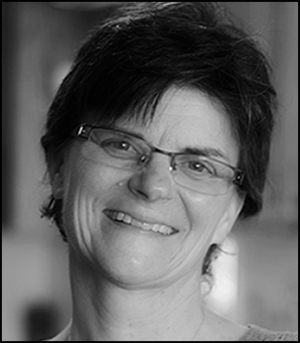 Tutorial written by Amy FlanaganTutorial created using Adobe Photoshop CS4 on Windows 7 Professional
Tutorial written by Amy FlanaganTutorial created using Adobe Photoshop CS4 on Windows 7 Professional













